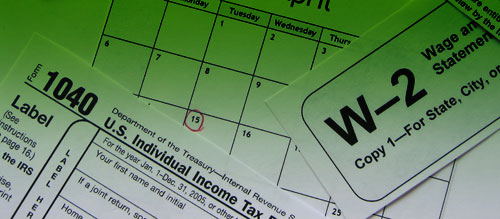One thing that I’ve had to do this year that I’ve never had to do before was to pay estimated taxes.
Normally all of my income has taxes withheld by my employer, so I never have to worry about actually withholding taxes for myself.
This year I’ve started several small side projects that have ended up making me money. Because I’ve made enough money in those pursuits, it means that this year I’ll need to start paying estimated taxes.
I put off paying my estimated taxes until right before the deadline because I was dreading trying to figure out just how much I should be paying, I mean how are you supposed to estimate how much money you’re going to be making for they year?
Last night I sat down and figured it all out for my household. Here are some of the things I learned.

Quick Navigation
Who Should Make Estimated Tax Payments?
Normally when you’re working for a company they will withhold taxes from your paycheck to cover your tax bill. If it is figured correctly you shouldn’t have to pay tax at the end of the year.
If the amount that they withhold isn’t enough to cover your tax bill because you have investment income, self-employment income or other income not subject to withholding, you may need to make estimated tax payments. After all, our system is a pay as you go system – you can’t wait to pay your taxes until next year at tax time!
Safe Harbor Requirements For Estimated Taxes
To avoid penalties at tax time you will need to meet one of the following safe harbor requirements. You can meet the requirements through increased withholding at your job, estimated tax payments, or a combination of both. Different rules may apply for some taxpayers.
- Owe less than $1,000 for this year’s taxes. (we didn’t meet this one, our tax bill will be substantially higher)
- Withhold 100% of last year’s tax liability. (We’re doing this one because it’s easiest to calculate)
- Withhold 90% of this year’s tax liability. (Do you know what it’s going to be?)
After filling out the government worksheet, form 1040-ES, we’re withholding 100% of last year’s tax liability in order to avoid penalties.
Some of the withholding will be done through our paychecks, and the rest through estimated tax payments. We’ll also start saving up for the remaining balance of the taxes we’ll have to pay next April.
How To Pay Your Estimated Tax
If you are filing estimated taxes this year, the deadline for the first quarter is April 15th, the same as your personal taxes.
To get started on the process, do these things:
- Fill out your estimated tax form to figure out how much you need to pay: Download Form 1040-ES from the IRS. The form includes a worksheet that walks you through figuring out how much estimated tax you should be paying. You’ll need to have your prior year’s tax info handy including adjusted gross income, deductions, etc. In addition, many popular tax software will help you figure out the following year’s estimated tax liability based on your current year’s return. Confused about estimated taxes still? Check out the IRS help document, Publication 505, Tax Withholding and Estimated Tax.
- Pay your estimated taxes! Sign up for the “Electronic Federal Tax Payment System” (EFTPS), in order to pay your estimated taxes online via direct debit. Keep in mind that once you sign up you’ll need up to 15 days to receive your PIN information so that you can actually pay. If you’re a procrastinator like me, just fill out the estimated tax coupon included on the Form 1040-ES, and mail your taxes in before April 15th.
When Are Estimated Tax Payments Due?
If you’re making estimated tax payments, there are four quarterly payments that you’ll need to make. They are usually:
- April 15
- June 15
- September 15
- January 15
Note that the payments are NOT every 3 months, but are spaced unevenly. Don’t let one of them sneak up on you!
Don’t Forget State Estimated Tax Payments And Self Employment Tax
Remember, when you’re paying your estimated taxes for self-employment income, you’ll also need to pay your state estimated taxes (if your state has income tax) in addition to the self-employment tax of 15.3% (the social security and medicare portion of your tax).
It can be easy to underestimate how much you’ll actually need to set aside! Keep that in mind!
More Estimated Tax Information
- IRS: Estimated tax info from
- IRS: Publication 505, Tax Withholding and Estimated Tax
- IRS: Estimated tax form 1040-ES
- Paying Quarterly Estimated Taxes @ BankRate.com
Are you making estimated tax payments this year? Did you find the process confusing? Tell us about it in the comments!

Pete – Consider starting an S-corp. Much better from a taxation perspective.
Andys last blog post..Can’t afford to pay my taxes! What happens if I file late and can I get an extension
Thanks for your comment! I appreciate your ministry for the Lord in talking about how He wants us to handle our treasure on earth. You have been a blessing!
For His glory,
Christopher Lynn
Chriss last blog post..I Will Rise
I almost forgot. My accountant figures it all and makes the payment coupons up for me, but sometimes I forget that I need to make that payment. It’s nice, because it makes things manageable for my LLC.